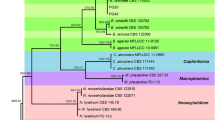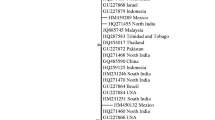Abstract
Anthracnose caused by Colletotrichum spp. is one of main strawberry diseases worldwide. The disease recently arrived in Iran and become epidemic in the Kurdistan province. A combination of morphological, molecular and pathogen-host interaction approaches (referred to the consolidated species concept) were applied to isolates from symptomatic strawberry tissues collected in Iran. Multi-gene phylogenetic analysis based on ITS-rDNA, beta-tubulin (TUB2) and glyceraldehyde-3-phosphate dehydrogenase (GAPDH) identified the species as the S5 clade of Colletotrichum nymphaeae. No significant intraspecies variation was observed in terms of morphology and pathogenicity. No significant genetic variation was observed among the isolates using inter simple sequence repeat analysis (ISSR) and primer pair combination of ERIC1/BOX and ERIC2/BOX fingerprinting markers. Based on the results of this study, it can be postulated that the C. nymphaeae population in Iran established itself from a single origin due to a founder effect. More generally, molecular dating based on relaxed clocks indicates co-radiation of C. nymphaeae S5 and strawberry plants and suggests high reciprocal specificity between the host and pathogen.



Similar content being viewed by others
References
Armengol, J., Vicent, A., Leo’n,M., Berbegal, M., Abad-Campos, P., & García-Jiménez, J. (2010). Analysis of population structure of Rosellinia necatrix on Cyperus esculentus by mycelial compatibility and inter-simple sequence repeats (ISSR). Plant Pathology, 59, 179–185.
Arzanlou, M., Bakhshi, M., Karimi, K., & Torbati, M. (2015). Multigene phylogeny reveals three new records of Colletotrichum spp. and several new host records for the mycobiota of Iran. Journal of Plant Protection Research, 55(2), 198–211.
Ayoubi, N., & Soleimani, J. (2013). Occurrence of strawberry anthracnose disease caused by Colletotrichum acutatum in Kurdistan province. 1th Iranian mycological congress. 3–5 September 2013. Rasht, Iran: University of Guilan.
Baroncelli, R., Zapparata, A., Sarrocco, S., Sukno, S. A., Lane, C. R., Thon, M. R., Vannacci, G., Holub, E., & Sreenivasaprasad, S. (2015). Molecular diversity of anthracnose pathogen populations associated with UK strawberry production suggests multiple introductions of three different Colletotrichum species. PloS One, 10(6), e0129140.
Bernstein, B., Zehr, E. I., Dean, R. A., & Shabi, E. (1995). Characteristics of Colletotrichum from peach, apple, pecan, and other hosts. Plant Disease, 79, 478–482.
Brown, A. E., Sreenivasaprasad, S., & Timmer, L. W. (1996). Molecular characterization of slow-growing orange and key lime anthracnose strains of Colletotrichum from citrus as C. acutatum. Phytopathology, 86, 523–527.
Buddie, A. G., Martínez-Culebras, P., Bridge, P. D., Garcia, M. D., Querol, A., Cannon, P. F., & Monte, E. (1999). Molecular characterization of Colletotrichum strains derived from strawberry. Mycological Research, 103(4), 385–394.
Cai, L., Hyde, K. D., Taylor, P. W. J., Weir, B. S., Waller, J., Abang, M. M., Zhang, J. Z., Yang, Y. L., Phoulivong, S., Liu, Z. Y., Prihastuti, H., Shivas, R. G., McKenzie, E. H. C., & Johnston, P. R. (2009). A polyphasic approach for studying Colletotrichum. Fungal Diversity, 39, 183–204.
Curry, K. J., Abril, M., Avant, J. B., & Smith, B. J. (2002). Strawberry anthracnose: Histopathology of Colletotrichum acutatum and C. fragariae. Phytopathology, 92, 1055–1063.
Damm, U., Woudenberg, J.H.C., Cannon, P.F., & Crous, P.W. (2009). Colletotrichum species with curved conidia from herbaceous hosts. Fungal Diversity, 39, 45–87.
Damm, U., Cannon, P. F., Woudenberg, J. H. C., & Crous, P. W. (2012). The Colletotrichum acutatum species complex. Studies in Mycology, 73, 37–114.
Denoyes-Rothan, B., Guérin, G., Délye, C., Smith, B., Minz, D., Maymon, M., & Freeman, S. (2003). Genetic diversity and pathogenic variability among isolates of Colletotrichum species from strawberry. Phytopathology, 93, 219–228.
Drummond, A. J., & Rambaut, A. (2007). BEAST: Bayesian evolutionary analysis by sampling trees. BMC Evolutionary Biology, 7, 214.
Faedda, R., Agosteo, G. E., Schena, L., Mosca, S., Frisullo, S., Magnano, d. S. L. G., & Cacciola, S. O. (2011). Colletotrichum clavatum sp. nov. identified as the causal agent of olive anthracnose in Italy. Phytopathologia Mediterranea, 50, 283–302.
Forster, H., & Adaskaveg, J. E. (1999). Identification of subpopulations of Colletotrichum acutatum and epidemiology of almond anthracnose in California. Phytopathology, 89(11), 1056–1065.
Freeman, S., & Katan, T. (1997). Identification of Colletotrichum species responsible for anthracnose and root necrosis of strawberry in Israel. Phytopathology, 87, 516–521.
Glass, N. L., & Donaldson, G. (1995). Development of primer sets designed for use with PCR to amplify conserved genes from filamentous ascomycetes. Applied and Environmental Microbiology, 61, 1323–1330.
Guerber, J. C., Liu, B., Correll, J. C., & Johnston, P. R. (2003). Characterization of diversity in Colletotrichum acutatum sensu lato by sequence analysis of two gene introns, mtDNA and intron RFLPs, and mating compatibility. Mycologia, 95, 872–895.
Hall, T. A. (1999). BioEdit: a user-friendly biological sequence alignment editor and analysis program for windows 95/98/NT. Nucleic Acids Symposium Series, 41, 95–98.
Hantula, J., Lilja, A., & Parikka, P. (1997). Genetic variation and host specificity of Phytophthora cactorum isolated in Europe. Mycological Research, 101, 565–572.
Howard, C. M., Maas, J. L., Chandler, C. K., & Albregts, E. E. (1992). Anthracnose of strawberry caused by the Colletotrichum complex in Florida. Plant Disease, 76, 976–981.
Hyde, K. D., Cai, L., Cannon, P. F., Crouch, J. A., Crous, P. W., Damm, U., et al. (2009). Colletotrichum: names in current use. Fungal Diversity, 39, 147–182.
Johnston, R. P., & Jones, D. (1997). Relationships among Colletotrichum isolates from fruit-rots assessed using rDNA sequences. Mycologia, 89(3), 420–430.
Kasuga, T., White, T. J., & Taylor, J. W. (2002). Estimation of nucleotide substitution rates in Eurotiomycete fungi. Molecular Biology and Evolution, 19(12), 2318–2324.
Kück, P., & Meusemann, K. (2010). FASconCAT: Convenient handling of data matrices. Molecular Phylogenetics and Evolution, 56, 1115–1118.
Lardner, R., Johnston, P. R., Plummer, K. M., & Pearson, M. N. (1999). Morphological and molecular analysis of Colletotrichum acutatum sensu lato. Mycological Research, 103, 275–285.
Liyanage, H. D., McMillan Jr., R. T., & Kistler, H. C. (1992). Two genetically distinct populations of Colletotrichum gloeosporioides from citrus. Phytopathology, 82, 1371–1376.
Mahmodi, F., Kadir, J. B., Puteh, A., Pourdad, S. S., Nasehi, A., & Soleimani, N. (2014). Genetic Diversity and Differentiation of Colletotrichum spp. Isolates Associated with Leguminosae Using Multigene Loci. RAPD and ISSR. Plant Pathology Journal, 30(1), 10–24.
Mahuku, G. S., Henrı’quez, M. A., Mun˜ oz, J., & Buruchara, R. (2002). Molecular markers dispute the existence of the Afro-Andean group of the bean angular leaf spot pathogen, Phaeoisariopsis griseola. Phytopathology, 92, 580–589.
Möller, E. M., Bahnweg, G., & Geiger, H. H. (1992). A simple and efficient protocol for isolation of high molecular weight DNA from filamentous fungi, fruit bodies, and infected plant tissues. Nucleic Acids Research, 20(22), 6115–6116.
Nasehi, A., Kadir, J., Rashid, T. S., Awla, H. K., Golkhandan, E., & Mahmodi, F. (2016). Occurrence of anthracnose fruit rot caused by Colletotrichum nymphaeae on pepper (Capsicum annuum) in Malaysia. Plant Disease. doi:10.1094/PDIS-08-15-0876-PDN.
Nirenberg, H. I., Feiler, U., & Hagedorn, G. (2002). Description of Colletotrichum lupini comb.nov. in modern terms. Mycologia, 94, 307–320.
Njuguna, W., Liston, A., Cronn, R., Ashman, T.-L., & Bassil, N. (2013). Insights into phylogeny, sex function and age of Fragaria based on whole chloroplast genome sequencing. Molecular Phylogenetics and Evolution, 66, 17–29.
Nylander, J. A. A. (2004). MrModeltest v2. Program distributed by the author. Evolutionary Biology Centre: Uppsala University.
O’Donnell, K., & Cigelnik, E. (1997). Two divergent intragenomic rDNA ITS2 types within a monophyletic lineage of the fungus Fusarium are non orthologous. Molecular Phylogenetics and Evolution, 7, 103–116.
Photita, W., Taylor, P. W. J., Ford, R., Hyde, K. D., & Lumyong, S. (2005). Morphological and molecular characterization of Colletotrichum species from herbaceous plants in Thailand. Fungal Diversity, 18, 117–133.
Quaedvlieg, W., Binder, M., Groenewald, J. Z., Summerell, B. A., Carnegie, A. J., Burgess, T. I., & Crous, P. W. (2014). Introducing the Consolidated Species Concept to resolve species in the Teratosphaeriaceae. Persoonia, 33, 1–40.
Ratanacherdchai, K., Wang, H. K., Lin, F. C., & Soytong, K. (2010). ISSR for comparison of cross-inoculation potential of Colletotrichum capsici causing chilli anthracnose. African Journal of Microbiology Research, 4, 76–83.
Ronquist, F., & Huelsenbeck, J. P. (2003). MrBayes 3: Bayesian phylogenetic inference under mixed models. Bioinformatics, 19, 1572–1574.
Shivas, R. G., & Tan, Y. P. (2009). A taxonomic re-assessment of Colletotrichum acutatum, intro-ducing C. fioriniae comb. et stat. nov. and C. simmondsii sp. nov. Fungal Diversity, 39, 111–122.
Simmonds, J. H. (1965). A study of the species of Colletotrichum causing ripe fruit rots in Queensland. Queensland Journal of Agricultural and Animal Science, 22, 437–459.
Smith, B. J. (2008). Epidemiology and pathology of strawberry anthracnose: a north American perspective. Hortscience, 43(1), 69–73.
Smith, H., Wingfield, M. J., Crous, P. W., & Coutinho, T. A. (1996). Sphaeropsis sapinea and Botryosphaeria dothidea endophytic in Pinus spp. and Eucalyptus spp. in South Africa. South African Journal of Botany, 62, 86–88.
Sreenivasaprasad, S., & Talhinhas, P. (2005). Genotypic and phenotypic diversity in Colletotrichum acutatum, a cosmopolitan pathogen causing anthracnose on a wide range of hosts. Molecular Plant Pathology, 6, 361–378.
Sreenivasaprasad, S., Mills, P. R., & Brown, A. E. (1994). Nucleotide sequence of the rDNA spacer 1 enables identification of isolates of Colletotrichum as C. acutatum. Mycological Research, 98, 186–188.
Staden, R. (1996). The staden sequence analysis package. Molecular Biotechnology, 5(3), 233–241.
Sutton, B. C. (1992). The genus Glomerella and its anamorph Colletotrichum. In J. A. Bailey & M. J. Jeger (Eds.), Colletotrichum: biology, pathology and control (pp. 1–27). Wallingford: CAB International.
Talhinhas, P., Sreenivasaprasad, S., Neves-Martin, J., & Oliveira, H. (2005). Molecular and phenotypic analyses reveal association of diverse Colletotrichum acutatum groups and a low level of C. gloeosporioides with olive anthracnose. Applied and Environmental Microbiology, 71, 2987–2998.
Tehranifar, A., & Sarsaefi, M. (2002). Strawberry growing in Iran. Acta Horticulturae, 567, 547–549.
Ureña-Padilla, A. R., MacKenzie, S. J., Bowen, B. W., & Legard, D. E. (2002). Etiology and population genetics of Colletotrichum spp. causing crown and fruit rot of strawberry. Phytopathology, 92, 1245–1252.
van der Aa, H. A. (1978). A leaf spot of Nymphaea alba in the Netherlands. Netherlands Journal of Plant Pathology, 84, 109–115.
Velho, A. C., Stadnik, M. J., Casanova, L., Mondino, P., & Alaniz, S. (2014). First report of Colletotrichum nymphaeae causing apple bitter rot in southern Brazil. Plant Disease Note, 98(4), 56.
Versalovic, J., Koeuth, T., & Lupski, J. R. (1991). Distribution of repetitive DNA sequences in eubacteria and application to fingerprinting of bacterial genomes. Nucleic Acids Research, 19, 6823–6831.
Versalovic, J., Schneider, M., de Bruijn, F. J., & Lupski, J. R. (1994). Genomic fingerprinting of bacteria using repetitive sequence based polymerase chain reaction. Methods in Molecular and Cellular Biology, 5(1), 25–40.
White, T. J., Bruns, T., & Taylor, J. (1990). Amplification and direct sequencing of fungal ribosomal RNA genes for phylogenetics. In M. A. Innis, D. H. Gelfand, J. J. Sninsky, & J.W. White (Eds.), A guide to molecular methods and applications (pp. 482). New York: Academic Press, USA.
Whitelaw-Weckert, M. A., Curtin, S. J., Huang, R., Steel, C. C., Blanchard, C. L., & Roffey, P. E. (2007). Phylogenetic relationships and pathogenicity of Colletotrichum acutatum isolates from grape in subtropical Australia. Plant Pathology, 56, 448–463.
Yamagishi, N., Ishiyama, Y., Ogiso, H., Sato, T., & Tosa, Y. (2015). Life cycle and control of Colletotrichum nymphaeae, the causal agent of celery stunt anthracnose. Journal of General Plant Pathology, 81(4), 279–286.
Acknowledgments
The authors would like to thank the research deputy of the University of Tabriz in Iran and the Fondazione Edmund Mach in Italy for financial support.
Author information
Authors and Affiliations
Corresponding author
Electronic supplementary material
ESM 1 Supplementary Fig. 1
(DOCX 749 kb)
ESM 2 Supplementary Fig. 2
(DOCX 49 kb)
ESM 3 Supplementary Fig. 3
(DOCX 112 kb)
ESM 4 Supplementary Fig. 4
(DOCX 120 kb)
ESM 5 Supplementary Fig. 5
(DOCX 200 kb)
ESM 6 Supplementary Table 1
(DOCX 24.4 kb)
ESM 7 Supplementary Table 2
(DOCX 14 kb)
Rights and permissions
About this article
Cite this article
Karimi, K., Babai Ahari, A., Arzanlou, M. et al. Application of the consolidated species concept to identify the causal agent of strawberry anthracnose in Iran and initial molecular dating of the Colletotrichum acutatum species complex. Eur J Plant Pathol 147, 375–387 (2017). https://doi.org/10.1007/s10658-016-1009-4
Accepted:
Published:
Issue Date:
DOI: https://doi.org/10.1007/s10658-016-1009-4




